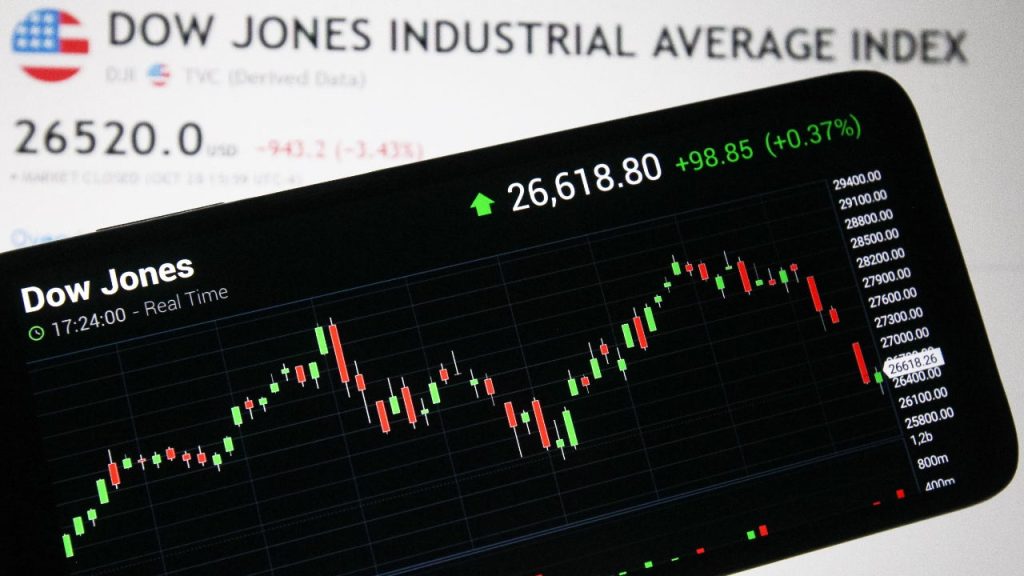SOPA Images/Contributor/Getty Images
The Dow Jones Industrial Average, also known as the Dow, is one of the most popular stock market indexes, along with the S&P 500 and Nasdaq Composite. The Dow tracks the stock performance of 30 large, blue chip companies.
Here are the details on the Dow Jones Industrial Average, including which companies are included in the index and how it is calculated.
The following 30 companies are included in the Dow Jones Industrial Average as of Nov. 8, 2024:
|
3M (MMM) |
Amazon.com (AMZN) |
American Express (AXP) |
|
Amgen (AMGN) |
Apple (AAPL) |
Boeing (BA) |
|
Caterpillar (CAT) |
Chevron (CVX) |
Cisco Systems (CSCO) |
|
Coca-Cola (KO) |
Goldman Sachs (GS) |
Home Depot (HD) |
|
Honeywell International (HON) |
International Business Machines (IBM) |
Johnson & Johnson (JNJ) |
|
JPMorgan Chase (JPM) |
McDonald’s (MCD) |
Merck & Co. (MRK) |
|
Microsoft (MSFT) |
Nike (NKE) |
Nvidia (NVDA) |
|
Procter & Gamble (PG) |
Salesforce (CRM) |
Sherwin-Williams (SHW) |
|
Travelers (TRV) |
UnitedHealth Group (UNH) |
Verizon Communications (VZ) |
|
Visa (V) |
Walmart (WMT) |
Walt Disney (DIS) |
*Note: Nvidia and Sherwin-Williams will replace Intel and Dow in the index before trading begins on Nov. 8, 2024.
How does a stock get added to the Dow Jones Industrial Average?
In order to be included in the Dow, a company must be part of the S&P 500 and cannot be part of the transportation or utilities industries (S&P Dow Jones Indices has other indexes that track these areas of the economy).
The S&P 500 itself has several requirements around things such as the company’s market capitalization, where the stock trades, profitability and trading volume.
Finally, the Dow Jones Industrial Average is maintained by a committee that includes three representatives from S&P Dow Jones Indices and two representatives from The Wall Street Journal.
Because the Dow is limited to 30 companies, when one company enters the index, another must leave. In November 2024, it was announced that Nvidia and Sherwin-Williams would replace Intel and Dow Inc. in the index.
The Dow Jones Industrial Average is a price-weighted index
The Dow is a price-weighted index, which means the stocks are weighted in the index based on their share price. This can create some unique situations, such as a company with a smaller market cap than other companies in the index having a larger weight because its share price is higher. Stock splits have a particularly large impact on price-weighted indexes for this reason.
For example, Apple is one of the largest companies in the world and, as of November 2024, has the largest weight in the market-cap-weighted S&P 500 based on its market cap of $3.35 trillion. But in the Dow, it has just the 13th largest weight, which is based on its share price of about $221. UnitedHealth Group has the largest weight in the Dow because of its $559 share price despite having a market cap that is less than 20 percent of Apple’s.
The price level of the Dow is calculated by adding the share prices of the companies in the index and dividing by the Dow divisor, a figure that is adjusted periodically for corporate actions such as dividend payments and stock splits.
Dow Jones Industrial Average vs. S&P 500
The Dow and the S&P 500 are probably the two most well-known stock market indexes, but there are a couple of key differences between the two.
- Diversification: The Dow includes just 30 large companies, while the S&P 500 includes about 500, making the latter a much broader and more diversified measure of the U.S. stock market and American business. Buying an S&P 500 index fund can be a great, simple investment for most individual investors because of the diversification benefits it provides. A fund tracking the Dow wouldn’t offer the same benefits.
- Weightings: The S&P 500 is a market-cap-weighted index, which means the largest companies will make up the largest amount of the index, whereas the Dow is price-weighted, which means the companies with the highest share prices will have the largest weight in the index.
Bottom line
The Dow tracks the stock performance of 30 blue chip, American companies. The index is price-weighted and dates back to 1896, making it one of the oldest stock market indexes. It’s not as diversified as broader indexes like the S&P 500, but it still provides a picture of how the stock market and large businesses are performing.
Editorial Disclaimer: All investors are advised to conduct their own independent research into investment strategies before making an investment decision. In addition, investors are advised that past investment product performance is no guarantee of future price appreciation.
Read the full article here

